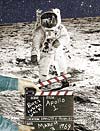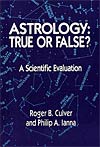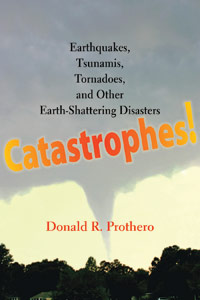In this week’s eSkeptic:

The solution to the Mystery Photo from March 30 is the helm of the 100-inch telescope atop Mt. Wilson, the Hooker instrument through which Hubble (the man, not the telescope!) solved the mystery of the “island universes” (were those fuzzy patches of light in the sky nebulae within the Milky Way or were they “island universes” in and of themselves), along with the expanding universe and other remarkable discoveries that expanded our visage of the cosmos. You can see the 100-inch Hooker’s blue base in the background, and in the foreground you can see a mouse pad and a mouse, part of the upgrade on the instruments used to run this magnificent piece of technology today.
We will reveal the answer to this week’s Mystery Photo in next week’s eSkeptic.

Catastrophes!
The 9.0 magnitude Tōhoku earthquake and tsunami which devastated Japan on March 11th, 2011 is being reported as one of the five most powerful earthquakes since seismological records began being kept in 1900. The awesome destructive power of our constantly changing world is highlighted by these kinds of disasters on a fairly regular basis, but does the understanding of when and how these events may happen change the way humans are choosing to live on dangerous planet Earth?
This week on Skepticality, Swoopy talks with Dr. Donald R. Prothero, professor of geology at Occidental College in Los Angeles and a lecturer in geobiology at Caltech about his new book Catastrophes! Earthquakes, Tsunamis, Tornadoes, and other Earth-Shattering Disasters which discusses not only the dangers we face from geographical challenges but also those that affect us all: overpopulation, and global climate change.
About this week’s feature article
For decades, controversy has surrounded the so-called “Mars Effect.” On one side, believers claim proof that astrological signs predict specific human outcomes (e.g. the success of sports stars). On the other side, skeptics claim that no such evidence has been demonstrated in controlled experiments and data analysis.
We ran an article by Alexander Panchin (The Saturn-Mars Effect) in volume 16, number 1 of Skeptic magazine offering an explanation for the effect as a statistical artifact. In this week’s eSkeptic, we present Australian skeptic Geoffrey Dean’s critical analysis of Panchin’s article followed by Panchin’s response.
SUBSCRIBE to Skeptic magazine for more great debates like these.
![By Heikenwaelder Hugo, Austria, Email : heikenwaelder@aon.at, www.heikenwaelder.at [CC-BY-SA-2.5 (www.creativecommons.org/licenses/by-sa/2.5)], via Wikimedia Commons](https://www.skeptic.com/eskeptic/2011/images/11-04-06/Universum.jpg)
The Mars Effect &
True Disbelievers
by Geoffrey Dean
According to Alexander Panchin in Vol. 16, No. 1, if you take 535 people in any profession and count the frequency of any planet (out of 10) in any two sectors (out of 12) at their birth, and randomize everything a million times, the highest mean total is nonsignificantly different from the observed total for Mars in sectors 1 and 4 for 535 eminent sports champions. So the Mars effect is “a statistical anomaly and nothing more.”
Such an explanation has been touted by skeptics again and again (Panchin is decades away from being the first), but it cannot possibly apply. Why? Because right from the start it was known that planetary effects (not just Mars effects) replicate—a point stressed in three of the references Panchin cites. Replication requires profession, planet and sectors to be specified in advance, so counting any planet in any two sectors for any profession is not relevant, especially when you assume that planets move independently (they don’t), that expectancies in each sector are equal (they aren’t), and that demography doesn’t matter (it does).
Incidentally Gauquelin did not use 535 champions (the Comité Para did), and 535 does not appear anywhere in the reference that Panchin cites for it. Nor were eminent sports champions the start of it all (it was eminent doctors).
Michel Gauquelin (1928–1991) was a Sorbonne graduate in psychology and statistics, and was fully aware of everything Panchin implies he was ignorant of. So his first priority after observing planetary effects was to see if they replicated. And they did. Again and again. Not just in France but also in Holland, Belgium, Germany, Italy, and America for a total of nearly thirty thousand eminent births. This work was done in the 1950s through the 1980s.
In 1987 the statistician I.J.Good “tried to dwindle the Mars effect, partly by allowing for ‘special selection’ of planet and attributes, and managed to get the Bayes factor down to about 60, but faced with the Saturn, Jupiter, and Moon effects, this approach will clearly not undermine Gauquelin’s results” (Journal of the American Statistical Association 98, 697–698, 1987).
Nor did tests by skeptics. Two decisive tests are shown in my figure. The results support a Mars effect.
Underlying both tests were True Disbelievers behaving badly towards (for them) inconvenient results. The Comité Para claimed that errors existed despite their own clear evidence to the contrary, which for eight years they failed to disclose. CSICOP spent five years dodging and weaving and casting personal slurs. Dr Richard Kammann (a CSICOP Fellow and co-author of The Psychology of the Psychic) spent seven months sifting the published papers and unpublished background papers and letters. He concluded that the CSICOP skeptics “have persisted in offering to the public a set of demonstrably false statistical arguments against the Mars effect in spite of four years of continuous and steadily mounting criticism of their illogic. … When the whole record is examined over five years, there is almost no instance in which merit wins out over self-serving bias” (Zetetic Scholar 10, 50–65, 1982; see 66–73 for articles on the Comité Para test).
Today there are eight independent studies and nearly thirty of Gauquelin’s replication studies. Meta-analysis confirms that planetary effect sizes are tiny (mean r = 0.044) but significant, see my chapter 13 in Brian Farha’s Paranormal Claims: A Critical Analysis (2007).
The problem of course is one of explaining how planets (not all of them, just some of them) could have an effect on people (just eminent people, not the 99.994% on Gauquelin’s figures who are not eminent), albeit with tiny effect sizes that could not be explained by artifacts of astronomy, demography, bias, data selection, or fraud (all favourite ploys of desperate skeptics). But there’s more.
Why no link with physical variables such as size and distance? Why no link with the Sun? Why is eminence important? Why is the effect larger for less-precise birth times? (This is like saying the more we tune our radio the worse the reception—it is definitely not what we expect.) And so on. It is these puzzles, not just planetary effects, that are the real challenge of Gauquelin’s work.
In fact the misreporting of birth data by a mere 3% of parents to suit pop astrological ideas current at the time seems enough to explain all the puzzles, see my article in Skeptical Inquirer for May/June 2002 available online. Most of the relevant births are from the 19th and early 20th centuries when planetary positions were publicly available and misreporting was easy. Its success at explaining all the puzzles (and the total failure of other artifacts) should dispel any doubts about its relevance.
Furthermore, misreporting (when possible) is almost universal. Eminent Americans and Congressmen misreport their birth date to make it coincide with a significant day, thus allowing “image enhancement through unit associations between oneself and positively evaluated stimuli” (Social Psychology Quarterly 51(4), 365–370, 1988), at a level notably more than for Gauquelin’s eminent professionals. Modern Asians control things at even higher levels to achieve birth years deemed auspicious by Chinese astrology (Population and Development Review 17, 663–686, 1991).
But misreporting will not explain planetary effects unless the effects disappear when births are reported by doctors instead of by parents, as was increasingly true in Europe after the second world war. As yet nobody knows if they do or not. But it could be argued that Gauquelin’s failure to observe a consistent Mars effect for sports champions born after 1950 has already put this point to the test. All that heat under the True Disbelievers’ collar seems to have been premature.
Sadly the existence of misreporting in birth data did not emerge until after Gauquelin’s death. He was ever the perfect scientist, always philosophical, confiding with a grin that he might or might not be right, and never sure he would live to see the puzzles solved. Today it seems clear that he was right and the True Disbelievers were wrong.
ABOUT THE AUTHOR: Geoffrey Dean is a technical editor in Perth, Western Australia, and a Fellow of the Committee for Skeptical Inquiry. He and his associates have been contributing critiques of astrology to Skeptical Inquirer since 1985.
Response from Alexander Panchin
To falsify the claim that the observed Mars Effect is an artifact induced by multiple-comparisons a single reference is sufficient. It must be a well-designed peer-reviewed study that would replicate the Mars Effect at a decent significance level involving a non-biased selection of eminent athletes (eminence being defined before the data is analyzed) and performed in a way that insures the complete independence of the athlete sample from the sample available at the time the Mars Effect was first described as eminent athletes being born more often under planet Mars in sectors 1 and 4. Such evidence is surely not so difficult to obtain in the era of digital technology. An example of how the replication of an association study is properly performed and described in non-fringe scientific fields such as molecular biology can be found online (Flachsbart et. al, PNAS February 24, 2009 vol. 106 no. 8 2700–2705)
To my current knowledge, available studies allegedly replicating the Mars Effect fail to match some or all of the mentioned requirements. For example Geoffrey Dean states that the Mars Effect is supported by the 303 sports-champions CSICOP test. But these 303 sports-champions were a subsample randomly chosen from Gauquelin’s sample. One may call this is an independent study, but it is not a study performed on an independent sample. Such studies cannot be used to exclude errors introduced by multiple-comparisons. If the Mars Effect is indeed an artifact introduced by multiple-comparisons, then the sample used by Gauquelin does contain a lot of eminent athletes born under planet Mars in sectors 1 and 4 and it is not unlikely that a random subsample of this sample will inherit this overrepresentation.
While Geoffrey Dean claims that the Mars Effect can be replicated he mentions that Gauquelin failed to “observe a consistent Mars effect for sports champions born after 1950” – which seems to be an argument against the previous statement. However, this is in agreement with certain studies, such as the U.S. study performed by Paul Kurtz and colleagues (Kurtz et. al 1979) that failed to replicate the Mars Effect. This is also in agreement with the idea that the Mars Effect initially observed by Gauquelin was a result of multiple-comparisons. In fact, Gauquelin was unlikely to not observe any false-positives (at a very good uncorrected significance level) considering the fact that he did study different professions and introduced even more multiple comparisons by analyzing subsamples of samples (such as eminent non-basketball players).
Geoffrey Dean states that the explanation of the Mars Effect due to the multiple-comparison error “has been touted by skeptics again and again”. I don’t see how this matters in relation to my argument, but I would like to note that no reference to an article in which this particular error is addressed is provided. I have found no discussion of multiple-comparisons in the works of Gauquelin or his successors. I believe that if I am merely ignorant on this subject it would be very easy for Geoffrey Dean to point that out with a single referenced quote. The argument that Michel Gauquelin was a graduate in statistics and was aware of the multiple-comparison error is an “appeal to accomplishment” fallacy. Other examples of “appeal to accomplishment” include mentioning the long periods of time certain astrological studies took to conduct, as if this would reflect their quality. Constantly referring to fellow skeptics as “True Disbelievers” is just judgmental language and not suitable for a public conversation on a scientific topic, even if it is actually fringe science we are talking about. I also believe that this subject hardly deserves any more attention than it currently has.
ABOUT THE AUTHOR: Alexander Y. Panchin graduated at the Lomonosov Moscow State University department of Bioengineering and Bioinformatics. Currently he is a research fellow in the sector of molecular evolution at the Institute for Information Transmission Problems of the Russian Academy of Science and a scientific journalist for the Novaya Gazeta newspaper where he specializes in writing articles that promote scientific advances and debunk pseudoscientific claims.
Skeptical perspectives on astrology and other misunderstandings…
-
 Bad Astronomy
Bad Astronomy
by Dr. Philip Plait (on DVD)
-
 Astrology: True or False?
Astrology: True or False?
by Roger Culver and Philip Lanna (paperback) -
Explains sun signs, house divisions, the zodiac, influences, the “Age of Aquarius,” and many other pseudoscientific astrology claims, giving the reader explanations for all major claims, including the all important “astrology works.” It doesn’t. READ more and order the book.
-
 Science Friction: Where the Known Meets the Unknown (abridged audio presentation)
Science Friction: Where the Known Meets the Unknown (abridged audio presentation)
by Michael Shermer (5 hrs. 30 min. on CD)

NEW ON SKEPTICBLOG.ORG
The Woo of Creation: My evening with Deepak Chopra
On Thursday, March 31, Deepak Chopra and I squared off for a second time in person in a public venue, this time accompanied by the physicist Leonard Mlodinow on my side and Stuart Hameroff on his side (along with other panelists). The question on the table was this: “Is there an Ultimate Reality?” and if yes, “Can it be accounted for by science such as mathematics, biology and physics?” My answers?
NEW ON MICHAELSHERMER.COM
UFOs, UAPs and CRAPs
In the April issue of Scientific American, Michael Shermer discusses how Unidentified Aerial Phenomena (UAP) offer a lesson on the residue problem in science.












